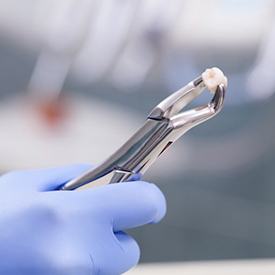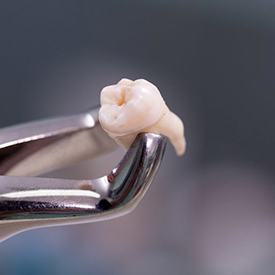Tooth Extractions – Arnold, MO
Remove Problematic Teeth and Protect Your Oral Health!

Is your tooth in significant pain due to a major oral injury or infection? Has decay reached past the many layers of enamel and begun breaking down your vulnerable pulp? Depending on the extent of your tooth’s damage, the dentists at JL Dental will do everything they can to restore it before resorting to an extraction. However, if the tooth’s root is too badly damaged or the tooth itself has sustained significant cracks or breakage, an extraction may be the only option. Call our office today to confirm and restore your oral health!
When is an Extraction Needed?

In most cases, teeth that need to be extracted are wisdom teeth that the mouth cannot properly accommodate. These teeth may have been useful to our hunter-gatherer ancestors who relied on them when their molars would eventually fall out, but now they cause more problems than they solve for most. If they erupt underneath existing teeth or get stuck under gum tissue, it can result in pain and the development an oral infection.
Other cases when a tooth is extracted include:
- Significant decay
- Gum disease
- Physical trauma
- When performing orthodontic treatment
- Oral infection
The Extraction Process

Depending on the nature of your tooth, either a simple or surgical extraction will be performed. Simple extractions are performed when the tooth is clearly visible and therefore easier to remove. Surgical extractions are done when the tooth is trapped underneath gum tissue and therefore requires a surgical incision in order to access. Once the tooth is clearly visible, our office uses a dental elevator to gently remove the tooth from the periodontal ligament holding it in place. After it’s been removed, a pair of dental forceps are used to firmly grasp the tooth and pull it from the jaw. Don’t worry, local anesthetic is provided to remove any potential discomfort. Those who fear dental treatment can also take advantage of oral conscious sedation to put themselves at ease.
Aftercare Tips to Keep in Mind

After your treatment is complete, you’ll need to take note of all aftercare tips that either Dr. Jonathan or Dr. Laura prescribes. These include but are not limited to:
- Taking painkillers as prescribed
- Keeping your gauze pad in place for several hours and replacing as needed
- Using a cold compress in 10-minute intervals to relieve swelling
- Resting for the next 24 hours
- Avoiding straws for the next 24 hours
- Rinsing your mouth with a saltwater solution after the first 24 hours
- Propping your head up while sleeping to promote healing
- Brushing and flossing as needed, making sure to avoid the extraction site
